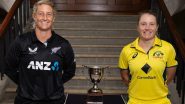Mumbai, August 2: In a groundbreaking discovery, wildlife photographer Dhruv Patil has captured a photograph of a leopard with heterochromia iridum in Karnataka's Bandipur Tiger Reserve. This rare genetic mutation, which causes each eye to have a different colour, has never before been documented in a big cat in India.
Patil, who was hosting a safari in Bandipur, spotted the elderly female leopard perched on a tree and clicked a photo of the big cat, News18 reported. Upon returning home and zooming into the photograph, he noticed the leopard had one bluish-green eye and one brown eye. "It’s incredible to document such rare mutations in such elusive creatures. Firstly, melanistic leopards like the black panther in Kabini and now heterochromic leopards in Bandipur. It’s truly incredible to witness Mother Nature’s marvels," the media outlet reported, quoting Patil, a member of the Karnataka State Wildlife Board, as saying. Leopard Injured, Biker Fractures His Leg After Collision on Ramanagara-Magadi Road in Karnataka, Video Surfaces.
What is Heterochromia?
Heterochromia is when a living thing has differently coloured eyes or eyes that have more than one colour. Most of the time, it doesn't cause any problems. It's often just a quirk caused by genes passed down from ancestors or by something that happened when your eyes were forming. In rare cases, it can be a symptom of a medical condition. Heterochromia is common in some animals but rare in humans. Leopards in Karnataka Adds Bats to Their Diverse Diet; Camera Trap Images Show Big Cat Carrying Indian Flying Fox.
Two Eye-Coloured Leopard of Bandipur
View this post on Instagram
Patil is no stranger to rare wildlife sightings. He previously captured a black panther at Kabini Wildlife Sanctuary near Mysuru, spending over 150 hours on a single road in the national forest to get the perfect shot. Additionally, he has photographed a rare albino deer in the Kabini forest area. According to Patil, the white or pale white skin of these deer is due to congenital defective genes and a lack of melanin pigment.
(The above story first appeared on LatestLY on Aug 02, 2024 04:39 PM IST. For more news and updates on politics, world, sports, entertainment and lifestyle, log on to our website latestly.com).













 Quickly
Quickly




















